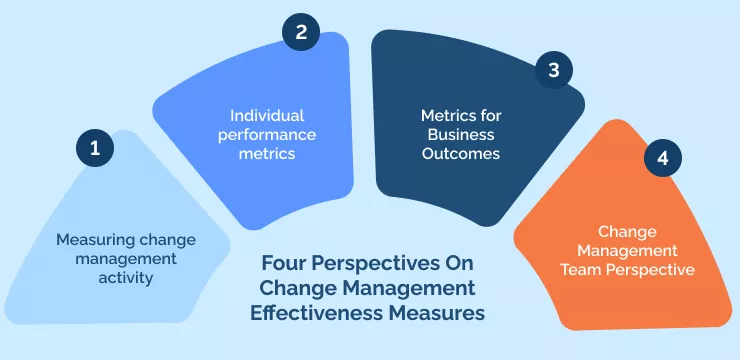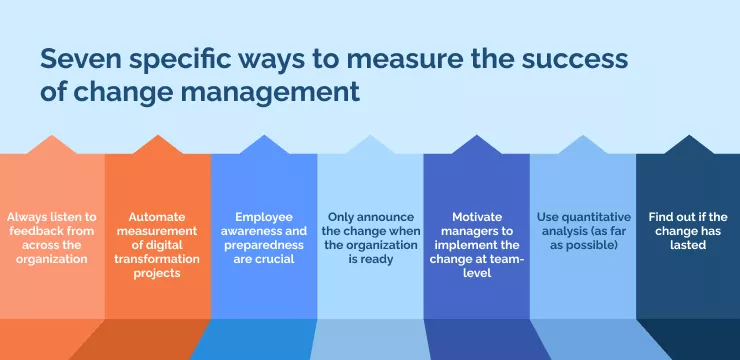
Finding a way to measure change management effectiveness is very important for any transformation project. Change is only meaningful when positive business outcomes have been achieved. So when companies are evaluating their change initiatives, it’s essential to know how to use appropriate effectiveness measures.
Planning for effective change management is more critical than ever. A 2022 Gartner report showed that between 2017 and 2022, the percentage of employees willing to support organizational change had shrunk from 74% to 38%.
So when executives are planning a change management effort, they must be very cautious. Any time they introduce a new system, it’s essential to learn from the outcomes, whether they are positive or negative. Organizational change management plays a critical role in the success of a transformation. This means that organizations need to measure whether their change initiatives have positively or negatively impacted them.
To get started with change management evaluation, this article will remind us of the aims of change management and why it is so important. It will describe different perspectives on measuring change management before offering several top tips for evaluating change initiatives.
What Is Change Management?
The practice of change management covers the entire process of managing and implementing organizational change. It involves planning, development, implementation, monitoring, and review. A change management team will supervise various activities, from establishing a vision for the change to developing strategies and plans for implementing it.
Organizations implement change management programs to improve their performance. Changes might be made to increase productivity or efficiency, introduce new products or services, update existing ones, align with changing market trends, modernize processes and technologies, or respond to changes in the external environment.
Perceptive managers and consultants can make some excellent decisions about implementing a change. But successful change management also requires an empathetic understanding of the employee journey within a company. Whatever change is in the works, employees drive organizational performance and must be brought along for the ride to achieve overall project success.
Why Is Effective Change Management Important?
Change management can only provide value to the organization when it is effective.
Change projects should always create value for a business through efficiencies, savings, and streamlining. And leaders only introduce changes when they stand to make such a positive difference.
But although organizational changes make sense in many situations, management teams can never be 100% certain that a planned change will function as planned. New technology may fail, innovative management structures might be unreliable, and organizational communications might fail to keep up with the necessary pace.
For these reasons and more, poor change management brings risks of major failures.
Because of the gains and losses a project might incur, there is no easy way to manage change. Well-managed projects will often provide significant resources to a change project, including people, money, and time. It also involves substantial shifts in how things are done, creating disruption, insecurity, and resistance from those affected.
Four Perspectives On Change Management Effectiveness Measures
The success of a change management process will look different depending on the company’s perspective. As such, the change management team must undertake careful planning to decide how they will assess the outcomes of the change.
Measuring change management activity
Any change initiative will include many activities to prepare everyone for change implementation.
Typical examples may include developing communications or vision statements, enhancing HR practices and policies, modifying IT systems, and training staff members. Such activities can be a fundamental part of the project or progress metrics.
Tracking such metrics enables the change management team to understand whether the activity is being used to bring outcomes. It also gives an idea about the speed of progress and the usage of the right kind of resources. Once the activities have been completed, and change has been implemented, metrics can shift to result-based measures.
Individual performance metrics
Organizational change should have a positive impact on individual performance. So, some companies choose to emphasize metrics that demonstrate the different behavior of individual employees.
Change leaders may seek to measure employee engagement, individual productivity, employee satisfaction, service requests, or the basic level of change adoption in the employee’s work.
Ideally, organizational change introduces new ideas and processes that can help motivate employees, break up monotonous routines, and create opportunities for employees to develop their skills and abilities. Changes can also lead to greater job satisfaction and improved communication between stakeholders.
Metrics for Business Outcomes
Another way to measure the result of a change is by inspecting business outcomes. Instead of evaluating individual performance, analyzing processes gives a more holistic view of the change’s success. Depending on the business unit in which the change has taken place, metrics for business outcomes might measure:
- The number of sales leads a team generates in a given period
- The speed at which a support desk solves problems
- The number of satisfactory customer interactions
- The average time is taken to fulfill an order
The change management team may be someone other than the company’s business experts. So, these metrics will be set by the employees and leaders engaged directly in the work of the company.
Change Management Team Perspective
Finally, the change management process should be subject to evaluation and review.
Whatever the perceived outcome of the project, the role of the change management team must be rigorously investigated. These metrics can then inform a company’s future change projects.
If the project was successful, KPIs for the change team perspective ask us who was responsible. Was the initiative’s success down to exceptional planning – or was it just due to the brilliant resilience of the organizational team?
Or did the change management team do everything they could if the change failed? What did they miss out on? A bad outcome does not necessarily mean the project was severely planned or executed. Metrics and evaluation paint a clear picture of the situation.
Seven specific ways to measure the success of change management
Although it’s challenging to find the best method to measure the success of a change project, there are several tried-and-tested approaches. This section will offer an overview of the critical possibilities.
A change management project’s performance metrics should be decided before the project start. The metrics must be tailored to the specific goals and objectives of the project. Change management teams should consult with stakeholders to determine the most relevant KPIs. Those metrics will then be tracked throughout the project.
Always listen to feedback from across the organization
Staff feedback is essential to measure the effectiveness of change management.
Through surveys, interviews, focus groups, and analysis of support requests, organizations can gain valuable insights into how employees respond to changes. This information helps identify areas of improvement in the change process and potential resistance that may need to be addressed.
It’s always early enough to start taking in feedback. Using feedback throughout the change management process will help to understand how each initiative stage is practical (or not).
Automate measurement of digital transformation projects
There are some challenges to successful change management when it comes to digital transformation projects.
It can be challenging to observe how staff engage with new technology. And when good practices follow from an implementation project, there may still be areas where the team could improve their use of critical techniques.
Digital adoption platforms provide a handy and effective way to measure project success across the organization. A good
Employee awareness and preparedness are crucial.
Employees have to be aware of planned changes, and they have to be ready for them.
Whatever new systems, software, or schedules an organization is introducing, employees are the people who will make plans succeed or fail. When employees know that the change will happen and understand how to deal with it, there is a far higher chance of success.
Awareness must be a key metric for any change management activity.
Only announce the change when the organization is ready
Experienced change management practitioners know that change can be disruptive. They also recognize that change management efforts will start badly if the company is not prepared to follow through on its high hopes.
When an enterprise is ready to handle the consequences of a change project, it can start explaining the matter to staff with empathy and care. If they still need to do the work, there’s no point trying.
Motivate managers to implement the change at team-level
Middle managers play an important role in the implementation of change management. They have the power and influence to drive teams through change initiatives but might need additional motivation.
Organizations must provide middle managers with clear objectives and expectations, a vision of the desired end state, and appropriate resources and support. The impact of these resources can be measured on an ongoing basis.
Use quantitative analysis (as far as possible)
Even though qualitative and quantitative data play a role in change management evaluation methods, quantitative data trends provide insights that can be easily monitored over time.
Companies should still be interested in the whole experience of employees. But when gathering qualitative feedback, a questionnaire with closed options instead of open responses can give a clearer picture of where the company is. Over time, employee satisfaction survey results can be easily compared.
After all, change in the organization’s culture or infrastructure requires behavior shits over many months or years. The new behaviors have to be ideally adopted in the company’s culture. Both employees and leaders need to demonstrate these changes consistently and readily.
Find out if the change has lasted
The ultimate measure of a successful change initiative is whether it has had a lasting positive impact on the organization.
Evaluating the success of a project is not, therefore, a one-off event. After implementing a new change, organizations should measure its success over time. Paying particular attention to key performance indicators such as customer satisfaction, quality control metrics, employee engagement, financial results, and other appropriate measures.
In short, the change management project team has responsibilities long after implementing the change.
Use the right change management metrics for long-term success
This article has explained how measuring change management effectiveness is essential to the overall change management process. In a large organization, it is easier to tell whether the desired outcomes are achieved if leadership undertakes a wide-ranging assessment of current progress.
Change management metrics and reviews can show where a project has excelled, but they can also provide valuable feedback while it is in process.
An insightful 2020 article from McKinsey advises that reviewing data gives an excellent way to produce insights about change performance: “Reviews enforce accountability, identify issues and best practices, determine remedies, spotlight successes, and instill a culture of continuous learning and improvement.”
In other words, Business Leaders who are serious about organizational change will also try to determine how to measure change management reliably. As we have seen, deciding on the correct change management metrics is complex, requiring input from many parts of the company.
WalkMe Team
WalkMe spearheaded the Digital Adoption Platform (DAP) for associations to use the maximum capacity of their advanced resources. Utilizing man-made consciousness, AI, and context-oriented direction, WalkMe adds a powerful UI layer to raise the computerized proficiency, everything being equal.







